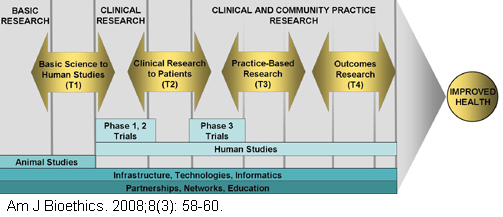To improve human health, scientific discoveries must be translated into
practical applications. Such discoveries typically begin at "the bench"
with basic research -- in which scientists study disease at a molecular
or cellular level -- then progress to the clinical level, or the patient's
"bedside".
Scientists are increasingly aware that this bench-to-bedside approach
to translational research is really a two-way street. Basic scientists
provide clinicians with new tools for use in patients and for assessment
of their impact, and clinical researchers make novel observations
about the nature and progression of disease that often stimulate basic
investigations.
Translational research has proven to be a powerful process that drives the
clinical research engine. However, a stronger research infrastructure
could strengthen and accelerate this critical part of the clinical
research enterprise. The NIH Roadmap attempts to catalyze translational
research.
Translational research includes two areas of translation. One is
the process of applying discoveries generated during research in the
laboratory, and in preclinical studies, to the development of trials
and studies in humans. The second area of translation concerns research
aimed at enhancing the adoption of best practices in the community.
This translation may seem like an automatic part of research and
medical practice, but in reality it is a major stumbling block in
science, medicine, and public health. This is partly due to the
compartmentalization of research training. Basic scientists are not
generally trained to think of the clinical application of their work,
clinicians are often not taught to formulate research studies based
on clinical observations, and public health scientists may not have a
strong background in basic or clinical research (but have the knowledge
of the community the other two groups may lack). These three groups
have long collaborated, but as our knowledge grows and research becomes
more complicated, it has become apparent that new ways of approaching
basic health problems are needed for seamless translation.
The first area of translation, from laboratory findings to clinical
practice (and visa versa.from clinical observations back to the laboratory
for further testing) is often called "bench to bedside and back" or T1
translation. The aim is to change paradigms so that biomedical
investigators and clinicians automatically include T1 translation in their
day-to-day research and patient care activities.
The second area of translation, to the community and back, is called T2
translation. T2 translation has long been the purview of public health
scientists, who study and facilitate the application of research findings
to the community.





